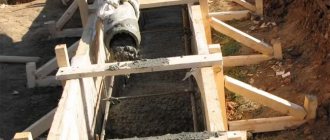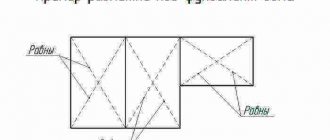A concrete mixer truck is a special machine designed for transportation and simultaneous preparation of concrete mixture. It is equipped with a rotating container into which the necessary ingredients for preparing concrete are poured. Below we will briefly consider the history of such transport, highlight its classification and types, and talk about the principle of operation. We will pay special attention to the best models based on the Kamaz vehicle.
How the first concrete trucks and concrete mixer trucks appeared
The history of concrete trucks and concrete mixer trucks began at the beginning of the 19th century in the USA. At first, separate mixers for transporting concrete appeared, and over time, concrete mixers on a chassis with the ability to load elements and prepare a solution on the way.
Stefan Stepanyan is considered the inventor of the first concrete mixer on a truck chassis. It was he who developed a new technical solution that gave impetus to the entire construction business. The operating principle of the machine is based on mixing the working composition inside the container during rotation. For his invention in 1954, Stepanyan received recognition from the National Cement Organization, and is still considered the “father” of this industry.
Few people know, but an application for a patent was sent by Stefan back in 1916, but then it was refused. The reason turned out to be the expert's doubts that the truck could support the weight. In 1928, he resubmitted the request and in 1933 the patent was finally received.
The reasons for this 17-year delay are still being debated. At the same time, in 1935, the preparation of concrete mixers intensified in the Soviet Union, and projects for two vehicles were developed.
One was used simply for transporting concrete, and the second was used for preparing construction mixture along the way. Over the next two years, 15 of these machines were produced. In 1937, a decision was made to unify such transport and combine the functions of a concrete truck and a concrete mixer.
What are the advantages of ordering a mixer?
The volume of concrete in the mixer is quite large. All components of the solution are mixed at the factory, loaded into a Kamaz and sent to the site. At the same time, the customer can be sure that the concrete exactly corresponds to the declared grade and all relevant parameters according to GOST. Concrete is delivered to the site in finished form and supplied to the pouring site.
Advantages of using a concrete mixer truck:
- Delivery of freshly prepared mixture directly to the site
- Exact compliance of the brand and technical characteristics with GOST
- Possibility of supplying the solution directly to the formwork
- Significant reduction in the share of manual labor - due to the absence of the need to prepare the mixture yourself and deliver it to the site (the solution is supplied through a chute)
- High speed of work implementation, absence of unnecessary seams, areas with low-quality concreting
- Delivery of concrete to any distance - small and large factories provide the service in Moscow and the regions, with precise adherence to transportation time
Concrete in KamAZ retains mobility, homogeneity, does not dry out and does not delaminate. Many modern models are equipped with pumps and various types of hoses to effectively move the mixture over a distance of several meters or more.
Design and principle of operation
The trucks in question are designed to prepare concrete along the route from the point of filling with dry components to the construction site.
Important
Structurally, they are trucks with a special chassis on which a special pear-shaped drum is installed. Sometimes the tank is mounted on separate chassis or semi-trailers.
Structurally, a standard concrete mixer truck consists of the following elements:
- water container;
- loading device where gravel, sand and cement are added;
- drum (mixer);
- drive unit;
- self-loading device.
The pear-shaped concrete container is tilted 10-15 percent for better mixing. Inside there are 2-blade screws that help in stirring the finished mixture. When rotating in one direction, loading occurs, and in the opposite direction, unloading occurs.
Loading/unloading is carried out through special devices. In addition, a water supply system is used to clean the internal cavity and mechanism elements from concrete. Structurally, it consists of a system for creating pressure, dosing and supplying water, as well as storage tanks. In general, all construction mixers in the form of concrete mixer trucks are of two types according to the principle of operation:
- Gravitational. In such devices, the drum has the shape of a pear, and mixing occurs with the help of blades and raising the solution upward. Once the composition is delivered to the limiting level, it falls under the influence of its own weight, and then the cycle repeats.
- Forced. Unlike the type discussed above, the drum does not move. In this case, the working container has the form of a trough/cylinder, and the containers move on a fixed shaft. This allows you to maintain a constant concrete mixing process and greater efficiency.
Domestic concrete mixer trucks differ little in their operating principle and equipment. Such devices can operate in a wide temperature range from -30 to +40 degrees Celsius. In this case, the maximum loading speed when full should not exceed 60 km/h.
Principle of operation
The operator drives the mixer to the materials storage area and places all the raw materials needed for production into the mixing drum with ladle. Then the mixing drum begins to mix all the materials, after the concrete mixing is completed, the operator sends the concrete mixture to the designated construction site, during transportation, the self-propelled concrete mixer will continue to mix the concrete to prevent the concrete mixture from freezing.
Types and classification of concrete mixers
Today, many types of concrete mixer trucks are used, which differ in several parameters. Concrete mixer trucks are:
- Stationary. In such devices, the concrete composition is prepared in one place without the possibility of movement.
- Mobile. They are made in the form of trailed devices and can be transported from the place where construction materials are filled to the point of construction of the facility.
- Self-loading. They are a machine on a 4x4 chassis, which has the option of self-loading, a dosing system and the function of rotating the drum 300-360 degrees.
In addition, concrete mixer trucks are divided into several types according to the installation of the mixing structure and the direction. Main types:
- Unloading "backwards". A more convenient option for most cases, allowing the machine to drive to the desired location and unload concrete with maximum accuracy. Such concrete mixer trucks are in greatest demand in Russia.
- Unloading forward. The peculiarity of this method is that the driver can control the process and accurately direct the flow of finished concrete.
The rotation of the working part is carried out using a special drive, which comes in two types:
- Mechanical. In this case, power is taken from the power unit through a group of mechanisms: chain transmission, gearbox with reverse.
- Hydromechanical. Unlike the previous version, power is taken from an autonomous motor, power take-off or chassis engine. In all cases, the basis is the hydromechanical principle.
In most cases, the hydromechanical principle of rotation is used. Its essence is that the transmission includes a hydraulic pump, a hydraulic motor with reverse and a planetary gearbox. The hydraulic pump supplies the mixture to the hydraulic motor, which ensures rotation of the pear-shaped container with concrete. The peculiarity of the hydromechanical drive mechanism is the ability to continuously adjust rotation with the creation of pressure at the level of 18-22 MPa.
Depending on the type of mixer motor used, there are two options:
- Autonomous. It is reliable, but produces more noise during operation. If the motor is suddenly damaged, the concrete continues to mix.
- On the chassis. Such units are more environmentally friendly, have lower noise levels and help reduce the weight of the machine.
In addition, modern truck-based construction mixers differ in capacity. It can be from 4 to 12 cubic meters.
Technical characteristics of vehicles on Kamaz chassis
In Russia, concrete mixer trucks based on Kamaz have become very popular. They are distinguished by their reliable design, long service life and ease of repair. Below we consider the most popular models.
Kamaz-581453
A truck equipped with a spacious concrete mixer capable of preparing up to 14 cubic meters. meters of solution in one go. The machine has a 3-axle design and a 6x4 wheel arrangement. The manufacturer has provided a high-quality hydraulic drive and a German power plant.
All the most loaded elements are made of high strength steel, which ensures a long service life of the machine. The equipment can be used to prepare the solution on site or loaded at another point with subsequent delivery to the construction site.
The advantages of the model include a powerful chassis, excellent all-terrain qualities, a convenient loading/unloading system and adaptability to domestic operating conditions. The drum is driven by a German HATZ-4M41 motor. The gearbox is made in Italy, is highly reliable and ensures correct transmission of torque.
Characteristics of KamAZ-581453:
- total weight - 27.5 tons;
- load capacity - 13.05 t;
- dimensions - 8.6x2.5x3.8 m;
- water tank capacity - 450 l;
- mixture volume - 14 cubic meters. m;
- loading / unloading height - 3.8 / 2.2 m;
- mixing time - 20 minutes;
- engine power - 320 horsepower.
KamAZ-58147s
The Kamaz 58147s concrete mixer truck is no less in demand in Russia. The equipment is manufactured on the basis of the “53229” chassis and is used for transporting concrete while maintaining its properties and subsequent unloading at the desired location. Can be operated in a temperature range from -20 to +40 degrees Celsius. It has an autonomous engine and tank, which ensures independent operation.
Features of the equipment include the presence of an Italian gearbox, which has a large reserve of torque and ensures reliable operation of the drive. In addition, an oil cooler made in Italy is installed, which extends the service life due to high heat transfer.
The most heavily loaded spare parts are made using special wear-resistant steel. The water supply system is heated by vehicle exhaust gases. The fuel pump is controlled using a special flexible cable.
Characteristics of KamAZ-58147s:
- total weight - 24 tons;
- dimensions - 9x2.5x3.7 m;
- water tank capacity - 450 l;
- mixture volume - 12 cubic meters. m;
- loading / unloading height - 3.7 / 2.2 m;
- mixing time - 20 minutes;
- engine power - 330 horsepower.
Kamaz-58149W
This is a concrete mixer truck on a Kamaz-65201 chassis with a 6x4 wheel arrangement. Designed for delivery of ready-made working mixture to the construction site. It has a restyled cabin with improved ergonomics and design. Features a redesigned mixing drum design, reduced weight of support rollers and improved rear support design.
The mixing drum rotates from the chassis engine with power take-off from the PTO. The work is based on a hydraulic drive system consisting of reliable elements. For example, a planetary gearbox is made in Italy or Germany. The oil cooler is also Italian or German made. The GST-90 gyrostatic transmission is made in Russia, and the elastic coupling is made in Germany.
Characteristics of KamAZ-581453:
- total weight - 33.1 tons;
- load capacity - 18.4 tons;
- dimensions - 8x2.5x3.8 m;
- water tank capacity - 800 l;
- mixture volume - 9 cubic meters. m;
- loading / unloading height - 3.8 / 2.35 m;
- engine power - 390 horsepower.
| Technical characteristics | Kamaz-581453 | KamAZ-58147s | Kamaz-58149W |
| Total weight, t | 27,5 | 24 | 33,1 |
| Load capacity, t | 13,05 | 15,9 | 18,4 |
| Dimensions (LxWxH), m | 8.6x2.5x3.8 | 9x2.5x3.7 | 8x2.5x3.8 |
| Water tank capacity, l | 450 | 450 | 800 |
| Volume of mixture, cubic meters m | 14 | 12 | 9 |
| Loading/unloading height, m | 3,8 / 2,2 | 3,7 / 2,2 | 3,8 / 2,35 |
| Engine power, l. With. | 320 | 320 | 390 |
Competitors and leaders among manufacturers
On the Russian market you can buy concrete mixer trucks from different manufacturers. The most popular in 2022 include:
- ABS-10DA vehicle based on MAZ 6516S9 for Euro-5. The equipment has been selling well for many years; it has a spacious 12 cubic meter mixer, which reduces the number of trips for loading and unloading. The car is equipped with a German gearbox and an engine from France, which is assembled in the Russian Federation. There are also no difficulties with the basic chassis.
- CIFASL 10 on MAN TGS chassis. Despite the higher price, this machine is in great demand. It has a 10 cc capacity and is hydraulically driven by the chassis motor. The main feature of the drum is the non-standard location of the transverse seam, which has a slight offset. This ensures more efficient mixing and complete discharge.
- TIGARBO ABS-7DA is a concrete mixer truck based on the Maz 6312s3 chassis. It has a new modern cabin with pre-heating of the engine and a comfortable cabin. The drum drive is powered by an autonomous motor made in Germany or Russia (depending on the configuration). The total loading volume is 7 cubic meters, and the total weight is 29.5 tons.
There are other options on the market in the Russian Federation, such as TZA ABSN-29 with an 8-cubic-meter drum, Liebherr with drums with a volume of 6 to 15 cubic meters. Also popular are equipment from the Steller company with mixers of 6-15 cubic meters or lightweight machines from Deutz with tanks from 7 to 9 “cubes”.
When choosing, you need to take into account that domestic products will be cheaper, and this is what many companies in Russia focus on. The honored leaders include equipment for delivering concrete with a mixer based on Kamaz or MAZ. If you have the required amount, you can consider foreign versions of equipment.
Options for calculating the amount of solution
There are several ways to calculate how much concrete will go into the mixer. Each master chooses the most suitable one for him.
Option 1
It does not give exact results - rather, it is an approximate calculation, which is based on the mass of concrete and assumes the personal presence of a specialist at the plant when washing the drum and loading the mixture. Before filling the concrete mixer, it is weighed (net weight), after filling the manipulations are repeated (gross weight). Then the first value is subtracted from the second value and the mass of the loaded material is obtained.
To calculate the number of cubes of mortar in the drum, you need to divide the weight of the concrete on the invoice by the density.
Density indicators:
- 500 kg/m3 – ultra-light concrete, foam concrete
- 500-800 kg/m3 is lightweight concrete
- 1800-2400 kg/m3 – indicator of heavy concrete
Option 2
This method allows you to calculate the volume of the mixture and the total load of equipment on the road surface. One cubic meter of the mixture weighs up to 2.4 tons - which means there are 16.8 tons of concrete in a 7-cubic drum.
The empty weight of a 7m3 truck mixer is 12.4 tons (curb weight), a loaded 7 cc concrete mixer truck weighs 29.2 tons.
Option 3
On average, a cubic meter of mixture is loaded in 10 minutes. If you track the time of unloading, you can approximately calculate the volume of the supplied mixture. First, the number of minutes of unloading is determined, then divided by 10. This way you can get the number of cubes of the mixture.
When choosing a reliable and conscientious supplier, you don’t have to worry about how many cubes of concrete fit in a concrete mixer. It is enough to calculate the volume of solution needed to complete the work and determine the optimal delivery time. Everything else is the responsibility of the supplier.











